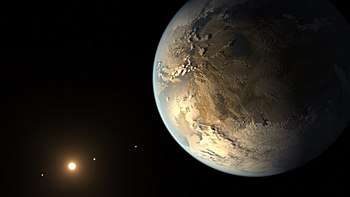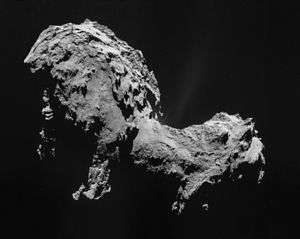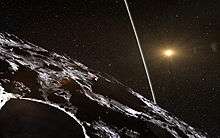2014 SC324
2014 SC324 is a sub-kilometer asteroid and fast rotator, classified as a near-Earth object of the Apollo group, approximately 50 meters in diameter.[2] It was first observed on 30 September 2014, by the Mount Lemmon Survey at an apparent magnitude of 21 using a 1.5-meter (59 in) reflecting telescope.[1] With an absolute magnitude of 24.3,[2] the asteroid is about 37–85 meters in diameter.[3]
| Discovery[1] | |
|---|---|
| Discovered by | Mt. Lemmon Survey (G96) |
| Discovery date | 30 September 2014 |
| Designations | |
| 2014 SC324 | |
| Orbital characteristics[2] | |
| Epoch 13 January 2016 (JD 2457400.5) | |
| Uncertainty parameter 1 | |
| Observation arc | 29 days w/Radar |
| Aphelion | 2.93880 AU (439.638 Gm) (Q) |
| Perihelion | 0.91503 AU (136.887 Gm) (q) |
| 1.92691 AU (288.262 Gm) (a) | |
| Eccentricity | 0.52513 (e) |
| 2.67 yr (976.99 d) | |
| 152.737° (M) | |
| 0° 22m 6.521s / day (n) | |
| Inclination | 1.65403° (i) |
| 210.19563° (Ω) | |
| 221.35334° (ω) | |
| Earth MOID | 0.000606726 AU (90,764.9 km) |
| Physical characteristics | |
| Dimensions | 37–85 m (generic)[3] |
| 0.36156 h (21.694 min) | |
| 24-29 (2014–2015) | |
| 24.3[2] | |
Description
The preliminary orbit with a short observation arc of 2 days showed that the asteroid had a very small chance of passing 0.000125 AU (18,700 km; 11,600 mi) from the Moon or 0.0012 AU (180,000 km; 110,000 mi) from Earth on about 23 October 2014.[4] But with an observation arc of 10 days, the nominal (best fit) orbit showed that on 24 October 2014 the asteroid would pass 0.0038 AU (570,000 km; 350,000 mi) (1.5 LD) from Earth and even further from the Moon.[5] The asteroid peaked at apparent magnitude 13.5,[6] placing it in the range of amateurs with roughly 0.25-meter (10 in) telescopes.
It was removed from the Sentry Risk Table on 10 October 2014 using JPL solution #5 with a 10-day observation arc.[7]
It was observed by Goldstone radar on 24–25 October 2014.[8]
References
- "MPEC 2014-T10 : 2014 SC324". IAU Minor Planet Center. 2 October 2014. Retrieved 2 October 2014. (K14SW4C)
- "JPL Small-Body Database Browser: (2014 SC324)" (last observation: 2014-10-29; arc: 29 days). Jet Propulsion Laboratory. Retrieved 4 April 2016.
- "Absolute Magnitude (H)". NASA/JPL. Retrieved 2 October 2014.
- Webcite capture of JPL solution #1 for asteroid 2014 SC324 on 2014-Oct-02
ArchiveToday capture of JPL solution #1 for asteroid 2014 SC324 on 2014-Oct-02. url: N4eGm - "JPL Close-Approach Data: (2014 SC324)" (last observation: 2014-10-29; arc: 29 days). Retrieved 10 October 2014.
- "2014SC324 Ephemerides for 23 October 2014 and 24 October 2014". NEODyS (Near Earth Objects – Dynamic Site). Retrieved 24 October 2014.
- "Date/Time Removed". NASA/JPL Near-Earth Object Program Office. Retrieved 10 October 2014.
- Dr. Lance A. M. Benner. "Goldstone Radar Observations Planning: 2340 Hathor, 2014 SM143, 2014 RQ17, 2014 TV, and 2014 SC324". NASA/JPL Asteroid Radar Research. Retrieved 30 October 2014.
External links
- Near-Earth Asteroid 2014 SC324: an exceptional movie (Virtual Telescope Project – 25 October 2014)
- 2014 SC324 at the JPL Small-Body Database


